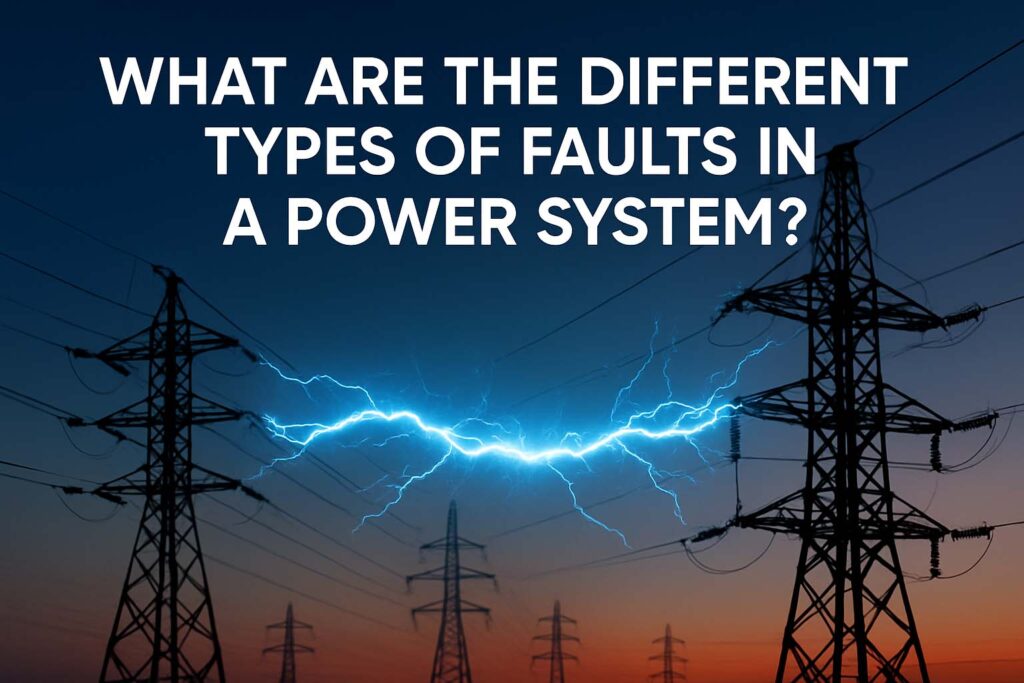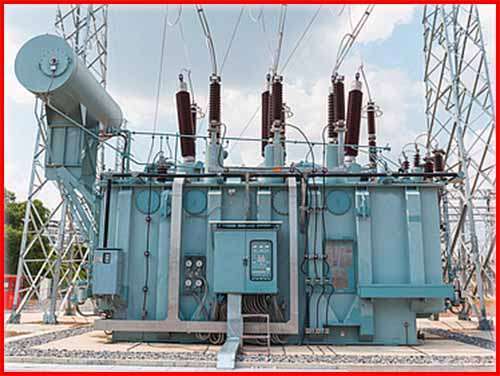What are the Different Types of Faults in a Power System?
Understanding the types of faults in a power system is crucial for engineers and technicians involved in power generation, transmission, and distribution. Faults can lead to equipment damage, power outages, and even hazardous conditions. That’s why early detection and proper protection are necessary.
Power systems are designed to be reliable. However, various external and internal factors can lead to faults. These faults are nothing but abnormal conditions that disrupt the normal flow of current.

This article gives you a detailed and easy-to-understand guide to all types of faults in a power system, their technical behavior, and how they affect electrical networks. You’ll also find insights into fault current calculation, protection strategies, and their relation to transformer performance and fault current distribution in star delta systems.
Classification of Faults in Power Systems
Power system faults are generally divided into two main categories:
- Symmetrical Faults
- Unsymmetrical Faults
Each has its unique impact on system stability, current flow, and relay protection schemes. Let’s dive into them.
Know more about Types of Alternator Protection
Symmetrical Faults in a Power System
Symmetrical faults are rare but severe. They affect all three phases equally, leading to a balanced short circuit. The most common type is a three-phase fault. This type of fault can occur due to insulation failure, lightning, or equipment breakdown.
Three-Phase Fault (L-L-L)
In this condition, all three phases short together, either with or without grounding. It leads to a high magnitude of fault current. It’s the easiest fault to analyze because the system remains balanced.
This fault is particularly important in the fault current calculation process used in system design and breaker selection. Although less frequent, it causes the maximum damage due to high current flow.
Example: A three-phase fault at the secondary of a transformer can lead to rapid overheating. That’s why engineers always calculate the fault current at transformer secondary for designing protection devices.
Unsymmetrical Faults in Power Systems
Unsymmetrical faults are more frequent but less severe than symmetrical faults. They result in unbalanced current and voltage, and therefore, more complicated analysis is needed. These faults include:
Line-to-Ground Fault (L-G)
This is the most common type, accounting for up to 70% of system faults. It occurs when one phase comes into contact with the ground. This can happen due to insulation breakdown or physical damage to overhead lines.
Know more about Differential Protection of Alternator
In this fault, only one phase current becomes abnormal. Therefore, current transformers and protective relays must be set precisely. It’s crucial to calculate fault current division factor to understand how much current returns through the ground.
Line-to-Line Fault (L-L)
This happens when two phases short with each other without involving the ground. These faults occur due to conductor snapping or bird strikes on transmission lines.
L-L faults cause high circulating current between phases, which can heat the conductors rapidly. Fault isolation must be quick to avoid long-term equipment stress.
Double Line-to-Ground Fault (L-L-G)
Here, two phases touch the ground simultaneously. The resulting fault current is higher than L-G but lower than a full three-phase fault.
These faults can confuse protective systems if settings aren’t accurate. The fault current of transformer feeding the line also plays a role in calculating the trip time for relays.
Know more about CT Polarity for Differential Protection
Open Conductor Faults
Although not short circuits, open conductor faults still disrupt the system. If one or two conductors break, loads become unbalanced. This can lead to equipment failure if not managed.
Example: If a conductor opens in a star-delta motor feed, the fault current distribution in star delta networks becomes uneven, which may overload the remaining windings.
Effects of Faults on Power Systems
Every type of fault causes abnormal conditions. The most important consequences are:
- Overheating of equipment
- Voltage dips or sags
- Mechanical stress on generators and motors
- Triggering of protective relays
- System instability
Table: Fault Types and Key Characteristics
| Fault Type | Phases Involved | Ground Involved | Common Cause | Severity |
|---|---|---|---|---|
| L-G | 1 | Yes | Insulation failure | Moderate |
| L-L | 2 | No | Line snapping | High |
| L-L-G | 2 | Yes | Tree contact | High |
| L-L-L | 3 | Optional | Equipment failure | Very High |
| Open Circuit | 1 or 2 | No | Mechanical break | Low to Moderate |
Know more about Overcurrent Protection of Transformer
Importance of Fault Current and Short Circuit Current
Understanding the fault current and short circuit current is vital in designing a power system. These currents determine the size of breakers, relays, and cables.
When a fault occurs, a sudden surge in current takes place. The maximum value of this surge is known as the short circuit current. Engineers must perform fault current calculation at every critical node to size protection devices properly.
For example, in systems using VFDs (Variable Frequency Drives), accurate fault current data ensures the drive doesn’t feed excess energy during a fault. Some drives are designed to block reverse feeding during abnormal conditions.
Transformer and Faults
Transformers are crucial in deciding the fault levels of a system. The fault current of transformer depends on its impedance and voltage level. A low impedance transformer can supply high fault current, which may require faster protection response.
Especially in fault current at transformer secondary, values can be very high due to lower impedance path. Therefore, secondary protection devices must be rated for such events.
In systems with multiple transformers, fault current division factor helps calculate how much fault current each transformer shares. This factor ensures that each unit is protected properly and does not get overloaded during faults.
Know more about What are the Three Types of Overcurrent?
Star-Delta Configurations and Fault Behavior
Many industrial loads use star delta configurations for motors and transformers. During faults, the current distribution between windings becomes critical.
The fault current distribution in star delta depends on the fault location and type. In case of a line-to-ground fault, the zero-sequence current may not return through delta windings, which can delay relay operation. Thus, protection must be coordinated accordingly.
How Frequency Drives React to Faults
Frequency drives (VFDs) play a role in fault management. In case of a short circuit, most drives detect the overcurrent and shut down to prevent damage.
However, if improperly configured, they can feed fault current back into the system. This can make fault current and short circuit current values unpredictable.
Therefore, engineers must ensure that VFD settings are aligned with system protection schemes. Drives should also be rated for fault withstand capacity.
How to Detect and Isolate Faults
Modern systems use digital relays and SCADA to detect faults in milliseconds. These relays use current and voltage data to calculate fault current division factor and identify the faulted zone.
Once the fault is detected, isolation takes place via circuit breakers. Protective relays must be coordinated to trip the nearest breaker and keep the rest of the system live.
Example Scenario:
- A three-phase fault occurs near the transformer.
- The relay detects a sudden rise in fault current at transformer secondary.
- The nearest breaker trips instantly.
- Other breakers remain closed to keep the supply stable elsewhere.
Conclusion
All types of faults in a power system pose risks to equipment and human safety. While symmetrical faults are rare, they demand high-capacity protection. Unsymmetrical faults are more common and require careful analysis due to their unbalanced nature.
Follow Us on Social:
Subscribe our Newsletter on Electrical Insights to get the latest updates in Electrical Engineering.
#TypesOfFaults, #PowerSystemFaults, #ElectricalFaults, #PowerSystem, #ElectricalEngineering, #FaultAnalysis, #ShortCircuit, #OpenCircuitFault, #SymmetricalFaults, #UnsymmetricalFaults, #RelayProtection, #TransmissionLineFaults, #PowerGrid, #ElectricalSafety, #EnergySystems




